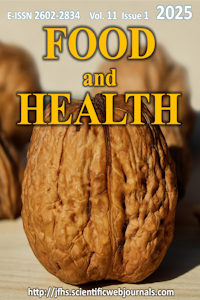Glutensiz kek üretiminde siyah pirinç unu ve siyah nohut ununun kullanım potansiyelinin araştırılması
Abstract
Yapılan çalışmada, son yıllarda rengi ve bileşimi ile dikkat çeken siyah pirinç unu (SPU) ve siyah nohut ununun (SNU) beyaz pirinç ununa (PU) alternatif olarak kullanımının araştırılması ile yeni bir glutensiz kek formülasyonunun geliştirilmesi amaçlanmıştır. Çalışmada kek formülasyonunda 1:1 oranlarında PU:SPU, PU:SNU, SPU:SNU kullanılarak üretilen örnekler tamamen PU kullanılarak üretilen kontrol örneği ile kıyaslanmıştır. SPU’nun ilavesi ile örneklerin renginin daha koyu olduğu gözlenirken, SNU ilavesinin örneklerin protein ve kül miktarını önemli derecede arttırdığı belirlenmiştir. SPU ve SNU’nun fenolik bileşenlerce oldukça zengin olduğu belirlenmiştir. Toplam fenolik madde miktarı kontrol örneğinde 70.05 mg GAE/100g olarak belirlenirken PU:SPU, PU:SNU, SPU:SNU örneklerinde sırasıyla 114.05 mg GAE/100g, 96.18 mg GAE/100g ve 147.63 mg GAE/100g olarak belirlenmiştir. Antioksidan aktivite değerleri kontrol örneği ile kıyaslandığında sırasıyla PU:SPU örneğinde 2.2 kat, PU:SNU örneğinde 1.4 kat, SPU:SNU örneğinde ise 3.0 kat daha yüksek olduğu görülmüştür. Ayrıca hem SPU hem de SNU ilavesinin kek örneklerinin mineral madde miktarında artış sağladığı saptanmıştır. Tüm bu özelliklerinin yanında SPU ve SNU’nun glutensiz kek formülasyonuna ilave edilmesinin duyusal özellikler açısından kabul edilebilir olduğu belirlenmiştir.
Keywords
Ethical Statement
Araştırma niteliği bakımından etik izne tabii değildir.
References
- AACC (2000). Approved methods of the Analysis (Method 10-91). American Association of Cereal Chemists, St. Paul, MN.
- Ali, A., Nongpiur, R.C., Chrungoo, N.K. (2023). An efficient Agrobacterium-mediated transformation and regeneration protocol for aromatic black rice, Oryza sativa L. (cv. Chakhao Poireiton and Chakhao Amubi). Plant Cell, Tissue and Organ Culture, 152(3), 619-633. https://doi.org/10.1007/s11240-022-02435-w
- Altuğ Onoğur, T., Elmacı, Y. (2011). Gıdalarda duyusal değerlendirme. Sidaş Medya, İzmir. ISBN: 978-9944-5660-8-7
- Anonim (2018). TS 2639 Pirinç unu standardı. Türk Standartları Enstitüsü, Ankara.
- AOAC (1990). Official methods of analysis (15th ed.). Association of Official Analytical Chemists. Washington, DC.
- Bedier, D., Salem, R., Almashad, A., Barakat, E. (2020). Quality characteristics of noodles containing various levels of black rice flour. Journal of Food and Dairy Sciences, 11(5), 141-146. https://doi.org/10.21608/jfds.2020.106997
- Boss, C.B., Fredeen, K.J. (2004). Concepts, instrumentation and techniques in inductively coupled plasma optical emission spectrometry (3rd ed.). Perkin Elmer Inc. USA.
- Çelik, C. (2021). Karpuz kabuğu tozunun glutensiz kekte kullanım potansiyeli. Yüksek Lisans Tezi. Pamukkale Üniversitesi, Fen Bilimleri Enstitüsü, Gıda Mühendisliği Anabilim Dalı, Denizli.
- Celik, I., Isik, F., Gursoy, O., Yilmaz, Y. (2013). Use of jerusalem artichoke (Helianthus tuberosus) tubers as a natural source of inulin in cakes. Journal of Food Processing and Preservation, 37(5), 483-488. https://doi.org/10.1111/j.1745-4549.2011.00667.x
- Colombo, F., Cappa, C., Bani, C., Magni, M., Biella, S., Restani, P., Di Lorenzo, C. (2023). Characterization of color, phenolic profile, and antioxidant activity of Italian pigmented rice varieties after different technological treatments. Food Bioscience, 53, 102674. https://doi.org/10.1016/j.fbio.2023.102674
- Costantini, M., Summo, C., Faccia, M., Caponio, F., Pasqualone, A. (2021). Kabuli and apulian black chickpea milling by-products as innovative ingredients to provide high levels of dietary fibre and bioactive compounds in gluten-free fresh pasta. Molecules, 26(15), 4442. https://doi.org/10.3390/molecules26154442
- Croitoru, C., Muresan, C., Turturica, M., Stanciuc, N., Andronoiu, D.G., Dumitrajscu, L., Barbu, V., Enachi (Ionita), E., Horincar (Parfene), G., Rapeanu, G. (2018). Improvement of quality properties and shelf life stability of new formulated muffins based on black rice. Molecules, 23(11), 3047. https://doi.org/10.3390/molecules23113047
- Çubuk, B., Özgören, E. (2023). Glutensiz Bisküvi Üretiminde Siyah Nohut Ununun Kullanımının Araştırılması. 6. Uluslararası Tarım, Çevre ve Sağlık Kongresi, Aydın. p. 50–60.
- De Pasquale, I., Verni, M., Verardo, V., Gómez-Caravaca, A. M., Rizzello, C.G. (2021). Nutritional and functional advantages of the use of fermented black chickpea flour for semolina-pasta fortification. Foods, 10(1), 182. https://doi.org/10.3390/foods10010182
- Demirkesen-Bicak, H., Tacer-Caba, Z., Nilufer-Erdil, D. (2018). Pullulanase treatments to increase resistant starch content of black chickpea (Cicer arietinum L.) starch and the effects on starch properties. International Journal of Biological Macromolecules, 111, 505-513. https://doi.org/10.1016/j.ijbiomac.2018.01.026
- Dhull, S.B., Punia, S., Kumar, M., Singh, S., Singh, P. (2021). Effect of Different Modifications (Physical and Chemical) on Morphological, Pasting, and Rheological Properties of Black Rice (Oryza sativa L. Indica) Starch: A Comparative Study. Starch/Staerke, 73, 2000098. https://doi.org/10.1002/star.202000098
- Dizlek, H., Altan, A. (2013). Pişirme öncesinde hamurun kısa süre bekletilmesinin pandispanya nitelikleri üzerine etkisi. GIDA, 38(1), 31–38.
- Fatchiyah, F., Sari, D.R.T., Safitri, A., Cairns, J.R.K. (2020). Phytochemical compound and nutritional value in black rice from Java Island, Indonesia. Systematic Reviews in Pharmacy, 11(7), 414-421.
- Hanifa, A.P., Millner, J.P., Mc Gill, C.R.M., Sjahril, R. (2020). Total anthocyanin, flavonoid and phenolic content of pigmented rice landraces from South Sulawesi. 247th ECS Meeting, IOP Conference Series: Earth and Environmental Science, 484, 012036. https://doi.org/10.1088/1755-1315/484/1/012036
- Ito, V.C., Lacerda, L.G. (2019). Black rice (Oryza sativa L.): A review of its historical aspects, chemical composition, nutritional and functional properties, and applications and processing technologies. Food Chemistry, 301, 125304. https://doi.org/10.1016/j.foodchem.2019.125304 Kırbaş, Z., Kumcuoglu, S., Tavman, S. (2019). Effects of apple, orange and carrot pomace powders on gluten-free batter rheology and cake properties. Journal of Food Science and Technology, 56(2), 914-926. https://doi.org/10.1007/s13197-018-03554-z
- Kose, B. E., Tacer-Caba, Z., Nilufer-Erdil, D. (2022). Simulated Digestion of the Pigmented Legumes’ (Black Chickpea (Cicer arietinum L.) and Brown Lentil (Lens culinaris Medikus) Phenolics to Estimate Their Bioavailability. Plant Foods for Human Nutrition, 77(4), 584-590. https://doi.org/10.1007/s11130-022-01006-w
- Kushwaha, U. K. S. (2016a). Black Rice Applications. In Black Rice Research, History and Development. Springer International Publishing, Cham. pp.105-113. ISBN: 978-3-319-30152-5. https://doi.org/10.1007/978-3-319-30153-2_7
- Kushwaha, U. K. S. (2016b). Nutrition Profiles of Black Rice. In Black Rice Research, History and Development. Springer International Publishing, Cham. pp.55-84. ISBN: 978-3-319-30152-5. https://doi.org/10.1007/978-3-319-30153-2_4
- Maurya, N.K., Yadav, L., Chaudhary, S. (2022). Nutraceutical Potentials of Black Rice. Research & Reviews: Journal of Food Science & Technology, 11(3), 27–35.
- Nashrurrokhman, M., Sayekti, P.R., Safitri, A.Y.U., Purwestri, Y.A., Pratiwi, R. (2019). Macronutrient and mineral contents of five local black rice (Oryza sativa) cultivars in Indonesia. Biodiversitas, 20 (12), 3647-3653. https://doi.org/10.13057/biodiv/d201225
- Özgören Çapraz, E. (2023). Koyu Renkli Yiyecekler: Siyah Yiyecekler. In Gastronomik Akımlar II; Türk Aslan, S., Ed.; İksad Yayınevi: Ankara, pp.143-162. ISBN: 978-625-367-361-1.
- Ozgoren, E., Isik, F., Yapar, A. (2019). Effect of Jerusalem artichoke (Helianthus tuberosus L.) supplementation on chemical and nutritional properties of crackers. Journal of Food Measurement and Characterization, 13(4), 2812-2821. https://doi.org/10.1007/s11694-019-00201-9
- Pal, S., Bagchi, T. B., Dhali, K., Kar, A., Sanghamitra, P., Sarkar, S., Samaddar, M., Majumder, J. (2019). Evaluation of sensory, physicochemical properties and Consumer preference of black rice and their products. Journal of Food Science and Technology, 56(3), 1484-1494. https://doi.org/10.1007/s13197-019-03634-8 Pasqualone, A., De Angelis, D., Squeo, G., Difonzo, G., Caponio, F., Summo, C. (2019). The effect of the addition of apulian black chickpea flour on the nutritional and qualitative properties of durum wheat-based bakery products. Foods, 8(10), 504. https://doi.org/10.3390/foods8100504
- Sahan, A., Ozgoren Capraz, E. (2024). The Effect of Okra Seed (Abelmoschus esculentus) Powder Supplementation on Nutritional, Textural, Microstructural, and Sensory Properties of Gluten‐Free Muffins. Journal of Food Quality, 2024, 9423583. https://doi.org/10.1155/2024/9423583
- Shao, Y., Hu, Z., Yu, Y., Mou, R., Zhu, Z., Beta, T. (2018). Phenolic acids, anthocyanins, proanthocyanidins, antioxidant activity, minerals and their correlations in non-pigmented, red, and black rice. Food Chemistry, 239, 733-741. https://doi.org/10.1016/j.foodchem.2017.07.009
- Singleton, V.L., Orthofer, R., Lamuela-Raventós, R.M. (1999). Analysis of total phenols and other oxidation substrates and antioxidants by means of folin-ciocalteu reagent. Methods in Enzymology, 299, 152-178. https://doi.org/10.1016/S0076-6879(99)99017-1
- Summo, C., De Angelis, D., Rochette, I., Mouquet-Rivier, C., Pasqualone, A. (2019). Influence of the preparation process on the chemical composition and nutritional value of canned purée of kabuli and Apulian black chickpeas. Heliyon, 5(3), e01361. https://doi.org/10.1016/j.heliyon.2019.e01361
- Thaipong, K., Boonprakob, U., Crosby, K., Cisneros-Zevallos, L., Byrne, D. H. (2006). Comparison of ABTS, DPPH, FRAP, and ORAC assays for estimating antioxidant activity from guava fruit extracts. Journal of Food Composition and Analysis, 19(6), 669–675. https://doi.org/10.1016/j.jfca.2006.01.003
- Toğay, Y., Toğay, N., Çiğ, F., Akkoç, G. (2019). Determination of some quality criteria and nutrient contents of local black chickpea genotypes growth in different locations. Applied Ecology and Environmental Research, 17(5), 10575-10585. https://doi.org/10.15666/aeer/1705_1057510585
- Topcu, A., Saldamlı, İ., Sağlam, F. (2014). Vitaminler ve Mineraller. In Gıda Kimyası; Saldamlı, İ., Ed.; Hacettepe Üniversitesi Yayınları: Ankara. pp. 411–478. ISBN:978-975-491-385-9.
- Yamauchi, J. (1989). Handbook of color science. Japanase Academy of Color Science. Tokyo: Japanese Academy of Color Science, Tokyo.
- Yaver, E. (2022). Nutritional and textural properties and antioxidant activity of breads prepared from immature, mature, germinated, fermented and black chickpea flours. Journal of the Science of Food and Agriculture, 102(15), 7164-7171. https://doi.org/10.1002/jsfa.12082
- Yıldırım, E. (2020). Çölyak Hastalığı ve Glutensiz Besleme. Necmettin Erbakan Üniversitesi Genel Sağlık Bilimleri Dergisi, 2(3), 175-187. https://doi.org/10.51123/jgehes.2020.8
- Yıldız, E. (2019). Glutensiz bisküvi üretiminde badem unu ve stevya kullanımı. Doktora Tezi. Bursa Uludağ Üniversitesi, Fen Bilimleri Enstitüsü, Gıda Mühendisliği Anabilim Dalı, Bursa.
- Zarzycki, P., Teterycz, D., Wirkijowska, A., Kozłowicz, K., Stasiak, D. M. (2021). Use of moldavian dragonhead seeds residue for pasta production. LWT, 143, 111099. https://doi.org/10.1016/j.lwt.2021.111099
Abstract
This study aimed to develop a new gluten-free cake formulation by investigating the use of black rice flour (BRF) and black chickpea flour (BCF), which have attracted attention with their color and composition in recent years, as an alternative to white rice flour (RF). The samples produced using RF:BRF, RF:BCF and BRF:BCF in the cake formulation at 1:1 ratios were compared to the control sample which was produced entirely with RF. It was observed that the addition of BRF resulted in a darker color in the samples, while the inclusion of BCF significantly increased their protein and ash content. BRF and BCF were found to be rich in phenolic compounds. The total phenolic content was determined to be 70.05 mgGAE/100g in the control sample, while it was found to be 114.05 mgGAE/100g, 96.18 mgGAE/100g and 147.63 mgGAE/100g in the RF:BRF, RF:BCF and BRF:BCF samples, respectively. Antioxidant activity of the RF:BRF sample was 2.2-times higher, RF:BCF sample was 1.4-times higher and BRF:BCF sample was 3.0-times higher than control sample. Additionally, it was found that the addition of both BRF and BCF increased the mineral matter content of the cake samples. Besides these properties, the inclusion of BRF and BCF to the gluten-free cake formulation was found to be acceptable in terms of all sensory properties.
References
- AACC (2000). Approved methods of the Analysis (Method 10-91). American Association of Cereal Chemists, St. Paul, MN.
- Ali, A., Nongpiur, R.C., Chrungoo, N.K. (2023). An efficient Agrobacterium-mediated transformation and regeneration protocol for aromatic black rice, Oryza sativa L. (cv. Chakhao Poireiton and Chakhao Amubi). Plant Cell, Tissue and Organ Culture, 152(3), 619-633. https://doi.org/10.1007/s11240-022-02435-w
- Altuğ Onoğur, T., Elmacı, Y. (2011). Gıdalarda duyusal değerlendirme. Sidaş Medya, İzmir. ISBN: 978-9944-5660-8-7
- Anonim (2018). TS 2639 Pirinç unu standardı. Türk Standartları Enstitüsü, Ankara.
- AOAC (1990). Official methods of analysis (15th ed.). Association of Official Analytical Chemists. Washington, DC.
- Bedier, D., Salem, R., Almashad, A., Barakat, E. (2020). Quality characteristics of noodles containing various levels of black rice flour. Journal of Food and Dairy Sciences, 11(5), 141-146. https://doi.org/10.21608/jfds.2020.106997
- Boss, C.B., Fredeen, K.J. (2004). Concepts, instrumentation and techniques in inductively coupled plasma optical emission spectrometry (3rd ed.). Perkin Elmer Inc. USA.
- Çelik, C. (2021). Karpuz kabuğu tozunun glutensiz kekte kullanım potansiyeli. Yüksek Lisans Tezi. Pamukkale Üniversitesi, Fen Bilimleri Enstitüsü, Gıda Mühendisliği Anabilim Dalı, Denizli.
- Celik, I., Isik, F., Gursoy, O., Yilmaz, Y. (2013). Use of jerusalem artichoke (Helianthus tuberosus) tubers as a natural source of inulin in cakes. Journal of Food Processing and Preservation, 37(5), 483-488. https://doi.org/10.1111/j.1745-4549.2011.00667.x
- Colombo, F., Cappa, C., Bani, C., Magni, M., Biella, S., Restani, P., Di Lorenzo, C. (2023). Characterization of color, phenolic profile, and antioxidant activity of Italian pigmented rice varieties after different technological treatments. Food Bioscience, 53, 102674. https://doi.org/10.1016/j.fbio.2023.102674
- Costantini, M., Summo, C., Faccia, M., Caponio, F., Pasqualone, A. (2021). Kabuli and apulian black chickpea milling by-products as innovative ingredients to provide high levels of dietary fibre and bioactive compounds in gluten-free fresh pasta. Molecules, 26(15), 4442. https://doi.org/10.3390/molecules26154442
- Croitoru, C., Muresan, C., Turturica, M., Stanciuc, N., Andronoiu, D.G., Dumitrajscu, L., Barbu, V., Enachi (Ionita), E., Horincar (Parfene), G., Rapeanu, G. (2018). Improvement of quality properties and shelf life stability of new formulated muffins based on black rice. Molecules, 23(11), 3047. https://doi.org/10.3390/molecules23113047
- Çubuk, B., Özgören, E. (2023). Glutensiz Bisküvi Üretiminde Siyah Nohut Ununun Kullanımının Araştırılması. 6. Uluslararası Tarım, Çevre ve Sağlık Kongresi, Aydın. p. 50–60.
- De Pasquale, I., Verni, M., Verardo, V., Gómez-Caravaca, A. M., Rizzello, C.G. (2021). Nutritional and functional advantages of the use of fermented black chickpea flour for semolina-pasta fortification. Foods, 10(1), 182. https://doi.org/10.3390/foods10010182
- Demirkesen-Bicak, H., Tacer-Caba, Z., Nilufer-Erdil, D. (2018). Pullulanase treatments to increase resistant starch content of black chickpea (Cicer arietinum L.) starch and the effects on starch properties. International Journal of Biological Macromolecules, 111, 505-513. https://doi.org/10.1016/j.ijbiomac.2018.01.026
- Dhull, S.B., Punia, S., Kumar, M., Singh, S., Singh, P. (2021). Effect of Different Modifications (Physical and Chemical) on Morphological, Pasting, and Rheological Properties of Black Rice (Oryza sativa L. Indica) Starch: A Comparative Study. Starch/Staerke, 73, 2000098. https://doi.org/10.1002/star.202000098
- Dizlek, H., Altan, A. (2013). Pişirme öncesinde hamurun kısa süre bekletilmesinin pandispanya nitelikleri üzerine etkisi. GIDA, 38(1), 31–38.
- Fatchiyah, F., Sari, D.R.T., Safitri, A., Cairns, J.R.K. (2020). Phytochemical compound and nutritional value in black rice from Java Island, Indonesia. Systematic Reviews in Pharmacy, 11(7), 414-421.
- Hanifa, A.P., Millner, J.P., Mc Gill, C.R.M., Sjahril, R. (2020). Total anthocyanin, flavonoid and phenolic content of pigmented rice landraces from South Sulawesi. 247th ECS Meeting, IOP Conference Series: Earth and Environmental Science, 484, 012036. https://doi.org/10.1088/1755-1315/484/1/012036
- Ito, V.C., Lacerda, L.G. (2019). Black rice (Oryza sativa L.): A review of its historical aspects, chemical composition, nutritional and functional properties, and applications and processing technologies. Food Chemistry, 301, 125304. https://doi.org/10.1016/j.foodchem.2019.125304 Kırbaş, Z., Kumcuoglu, S., Tavman, S. (2019). Effects of apple, orange and carrot pomace powders on gluten-free batter rheology and cake properties. Journal of Food Science and Technology, 56(2), 914-926. https://doi.org/10.1007/s13197-018-03554-z
- Kose, B. E., Tacer-Caba, Z., Nilufer-Erdil, D. (2022). Simulated Digestion of the Pigmented Legumes’ (Black Chickpea (Cicer arietinum L.) and Brown Lentil (Lens culinaris Medikus) Phenolics to Estimate Their Bioavailability. Plant Foods for Human Nutrition, 77(4), 584-590. https://doi.org/10.1007/s11130-022-01006-w
- Kushwaha, U. K. S. (2016a). Black Rice Applications. In Black Rice Research, History and Development. Springer International Publishing, Cham. pp.105-113. ISBN: 978-3-319-30152-5. https://doi.org/10.1007/978-3-319-30153-2_7
- Kushwaha, U. K. S. (2016b). Nutrition Profiles of Black Rice. In Black Rice Research, History and Development. Springer International Publishing, Cham. pp.55-84. ISBN: 978-3-319-30152-5. https://doi.org/10.1007/978-3-319-30153-2_4
- Maurya, N.K., Yadav, L., Chaudhary, S. (2022). Nutraceutical Potentials of Black Rice. Research & Reviews: Journal of Food Science & Technology, 11(3), 27–35.
- Nashrurrokhman, M., Sayekti, P.R., Safitri, A.Y.U., Purwestri, Y.A., Pratiwi, R. (2019). Macronutrient and mineral contents of five local black rice (Oryza sativa) cultivars in Indonesia. Biodiversitas, 20 (12), 3647-3653. https://doi.org/10.13057/biodiv/d201225
- Özgören Çapraz, E. (2023). Koyu Renkli Yiyecekler: Siyah Yiyecekler. In Gastronomik Akımlar II; Türk Aslan, S., Ed.; İksad Yayınevi: Ankara, pp.143-162. ISBN: 978-625-367-361-1.
- Ozgoren, E., Isik, F., Yapar, A. (2019). Effect of Jerusalem artichoke (Helianthus tuberosus L.) supplementation on chemical and nutritional properties of crackers. Journal of Food Measurement and Characterization, 13(4), 2812-2821. https://doi.org/10.1007/s11694-019-00201-9
- Pal, S., Bagchi, T. B., Dhali, K., Kar, A., Sanghamitra, P., Sarkar, S., Samaddar, M., Majumder, J. (2019). Evaluation of sensory, physicochemical properties and Consumer preference of black rice and their products. Journal of Food Science and Technology, 56(3), 1484-1494. https://doi.org/10.1007/s13197-019-03634-8 Pasqualone, A., De Angelis, D., Squeo, G., Difonzo, G., Caponio, F., Summo, C. (2019). The effect of the addition of apulian black chickpea flour on the nutritional and qualitative properties of durum wheat-based bakery products. Foods, 8(10), 504. https://doi.org/10.3390/foods8100504
- Sahan, A., Ozgoren Capraz, E. (2024). The Effect of Okra Seed (Abelmoschus esculentus) Powder Supplementation on Nutritional, Textural, Microstructural, and Sensory Properties of Gluten‐Free Muffins. Journal of Food Quality, 2024, 9423583. https://doi.org/10.1155/2024/9423583
- Shao, Y., Hu, Z., Yu, Y., Mou, R., Zhu, Z., Beta, T. (2018). Phenolic acids, anthocyanins, proanthocyanidins, antioxidant activity, minerals and their correlations in non-pigmented, red, and black rice. Food Chemistry, 239, 733-741. https://doi.org/10.1016/j.foodchem.2017.07.009
- Singleton, V.L., Orthofer, R., Lamuela-Raventós, R.M. (1999). Analysis of total phenols and other oxidation substrates and antioxidants by means of folin-ciocalteu reagent. Methods in Enzymology, 299, 152-178. https://doi.org/10.1016/S0076-6879(99)99017-1
- Summo, C., De Angelis, D., Rochette, I., Mouquet-Rivier, C., Pasqualone, A. (2019). Influence of the preparation process on the chemical composition and nutritional value of canned purée of kabuli and Apulian black chickpeas. Heliyon, 5(3), e01361. https://doi.org/10.1016/j.heliyon.2019.e01361
- Thaipong, K., Boonprakob, U., Crosby, K., Cisneros-Zevallos, L., Byrne, D. H. (2006). Comparison of ABTS, DPPH, FRAP, and ORAC assays for estimating antioxidant activity from guava fruit extracts. Journal of Food Composition and Analysis, 19(6), 669–675. https://doi.org/10.1016/j.jfca.2006.01.003
- Toğay, Y., Toğay, N., Çiğ, F., Akkoç, G. (2019). Determination of some quality criteria and nutrient contents of local black chickpea genotypes growth in different locations. Applied Ecology and Environmental Research, 17(5), 10575-10585. https://doi.org/10.15666/aeer/1705_1057510585
- Topcu, A., Saldamlı, İ., Sağlam, F. (2014). Vitaminler ve Mineraller. In Gıda Kimyası; Saldamlı, İ., Ed.; Hacettepe Üniversitesi Yayınları: Ankara. pp. 411–478. ISBN:978-975-491-385-9.
- Yamauchi, J. (1989). Handbook of color science. Japanase Academy of Color Science. Tokyo: Japanese Academy of Color Science, Tokyo.
- Yaver, E. (2022). Nutritional and textural properties and antioxidant activity of breads prepared from immature, mature, germinated, fermented and black chickpea flours. Journal of the Science of Food and Agriculture, 102(15), 7164-7171. https://doi.org/10.1002/jsfa.12082
- Yıldırım, E. (2020). Çölyak Hastalığı ve Glutensiz Besleme. Necmettin Erbakan Üniversitesi Genel Sağlık Bilimleri Dergisi, 2(3), 175-187. https://doi.org/10.51123/jgehes.2020.8
- Yıldız, E. (2019). Glutensiz bisküvi üretiminde badem unu ve stevya kullanımı. Doktora Tezi. Bursa Uludağ Üniversitesi, Fen Bilimleri Enstitüsü, Gıda Mühendisliği Anabilim Dalı, Bursa.
- Zarzycki, P., Teterycz, D., Wirkijowska, A., Kozłowicz, K., Stasiak, D. M. (2021). Use of moldavian dragonhead seeds residue for pasta production. LWT, 143, 111099. https://doi.org/10.1016/j.lwt.2021.111099
Details
| Primary Language | Turkish |
|---|---|
| Subjects | Grain Technology |
| Journal Section | Research Articles |
| Authors | |
| Early Pub Date | December 24, 2024 |
| Publication Date | January 10, 2025 |
| Submission Date | October 3, 2024 |
| Acceptance Date | October 31, 2024 |
| Published in Issue | Year 2025Volume: 11 Issue: 1 |
Journal is licensed under a
CreativeCommons Attribtion-ShareAlike 4.0 International Licence 


Diamond Open Access refers to a scholarly publication model in which journals and platforms do not charge fees to either authors or readers.
Open Access Statement:
This is an open access journal which means that all content is freely available without charge to the user or his/her institution. Users are allowed to read, download, copy, distribute, print, search, or link to the full texts of the articles, or use them for any other lawful purpose, without asking prior permission from the publisher or the author. This is in accordance with the BOAI definition of open access.
Archiving Policy:
Archiving is done according to ULAKBİM "DergiPark" publication policy (LOCKSS).


